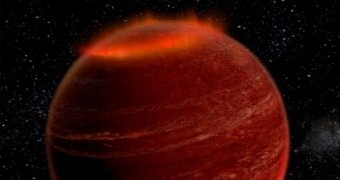A research paper published in today's issue of the journal Nature announces the discovery of the first ever alien auroras on a brown dwarf located at a distance of about 20 light-years from our planet.
Like the auroras that lit up the sky here on Earth, these alien ones are essentially stunning displays of color that form in the proximity of the dwarf planet's poles. What makes them a remarkable sight is the fact that they are thousands of times brighter than the auroras on our home planet.
So much so that they light up the brown dwarf completely. In fact, as illustrated in the video below, delivered by the National Radio Astronomy Observatory's Very Large Array, they make the orb pulse.
“If you were able to stand on the surface of the brown dwarf we observed, you would sometimes be treated to a fantastic light show courtesy of auroras hundreds of thousands of times more powerful than any detected in our solar system,” explains Caltech researcher Gregg Hallinan.
So, what's causing these alien auroras?
Here on Earth, auroras form when charged particles carried by stellar winds push through the planet's atmosphere and collide with gas atoms at altitudes ranging from 90 to 300 kilometers (56 to 186 miles).
When these collisions involve nitrogen atoms, blue or purplish-red auroras are born. Oxygen atoms, on the other hand, produce yellowish-green or intense red auroras. The color of auroras depends on the altitude at which the charged particles encounter the gas atoms and bump into them.
Astronomers believe that the same mechanisms are at play on the brown dwarf that they studied, except that, since there is no star in sight, the charged particles cannot be pushed around by stellar winds. Instead, it might be that what is guiding them is current produced by a planet orbiting the brown dwarf.
Caltech scientist Gregg Hallinan and his colleagues plan to further study the orb and the auroras that form near its magnetic poles in an attempt to determine the exact cause of this peculiar phenomenon.
A better understanding of brown dwarfs
Brown dwarfs are described by scientists as objects that, although too massive and too hot to be called planets, cannot be classified as stars either. Thus, they pack too little mass to sustain hydrogen fusion reactions at their core, which is a defining trait of stars.
Now that auroras have been detected on such a celestial body, it's safe to say that, unless other evidence comes to light, brown dwarfs can be considered to be more like planets than stars.
“We're finding that brown dwarfs are not like small stars in terms of their magnetic activity; they're like giant planets with hugely powerful auroras,” explained researcher Greg Hallinan.

 14 DAY TRIAL //
14 DAY TRIAL // 